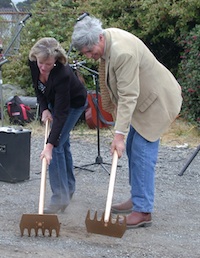Project will need state approval
6/7/12
The Eureka City Council approved the redirection of $1.2 million in funding from the defunct Waterfront Drive Extension project to a waterfront trail from Del Norte to Truesdale streets at its Tuesday meeting.
The city had secured more than $4.6 million for a project to extend Waterfront Drive but abandoned the project in April in the face of strong and ongoing opposition by the California Coastal Commission.
In a 4-1 vote Tuesday, Councilman Lance Madsen dissenting, the council directed staff to work with Caltrans and the Humboldt County Association of Governments to use funds from the project for construction of the trail and the remaining balance for other roadway improvements.
The funds were originally allocated to the city in conjunction with the waterfront drive extension, and the standalone trail will have to go before the California Transportation Commission for approval. The funds carry stipulations to improve the safety of the U.S. Highway 101 corridor.
Madsen praised the idea of the trail but said he didn’t think the project fit the conditions for which the funds were designated.
“There seems to be some confusion about what these non-freeway funds were designated for,” Madsen said.
He said he had not seen any findings that the trail would improve safety on Broadway, and expressed concern that the trail will increase traffic crossings on Broadway.
“There’s also a reasonable expectation that an increase in traffic will increase accidents,” Madsen said. “Public safety is the express priority of this council.” Councilwoman Linda Atkins predicted the project would have a positive effect.
“Taking bicycles and pedestrians off Broadway I think is a really good way to increase the safety there,” Atkins said.
Representatives from the Audobon Society, Redwood Community Action Agency, Humboldt Baykeeper and other organizations spoke during public comment, saying the trail would benefit local businesses, tourism and access to the waterfront.
Westside Improvement Association member Richard Evans said waterfront access would transform the Westside.
“The most successful coastal towns have embraced their waterfronts,” Evans said.
Councilwoman Marian Brady praised the project, adding that it was important to have law enforcement and public safety access to the area which she described as currently less than family-friendly.
“There are weird, strange people out there that jump out at you,” Brady said. Assistant City Manager Mike Knight said staff was aware of the need for public safety access, and was confident that $1.2 million would be enough to complete the project as the city envisions it. Knight said the project has Humboldt County Association of Governments support and believed that the project would be acceptable under the funds’ stipulations.
“I was hoping that if all of us in this area are in agreement about how this money should be spent, that should go a long ways in front of the California Transportation Commission,” Knight said.
In other business, the council voted unanimously to direct staff to implement a mandatory commercial recycling program which will affect 1,100 businesses and could start as soon as the end of the year.
The program will mean a increase in both commercial and residential rates, and will help Eureka move toward waste reduction, according to Deputy Public Works Director Miles Slattery.
Slattery said average residential customers will see a $1.30 per month increase. Commercial customers will see an increase of $8.50 per month, but Slattery said that many businesses will see reduced recycling costs as they move away from voluntary recycling programs that can be more costly.
Slattery said the program will double the amount of recycling done by the city and generate $30,000 per year.
Read Original Article



